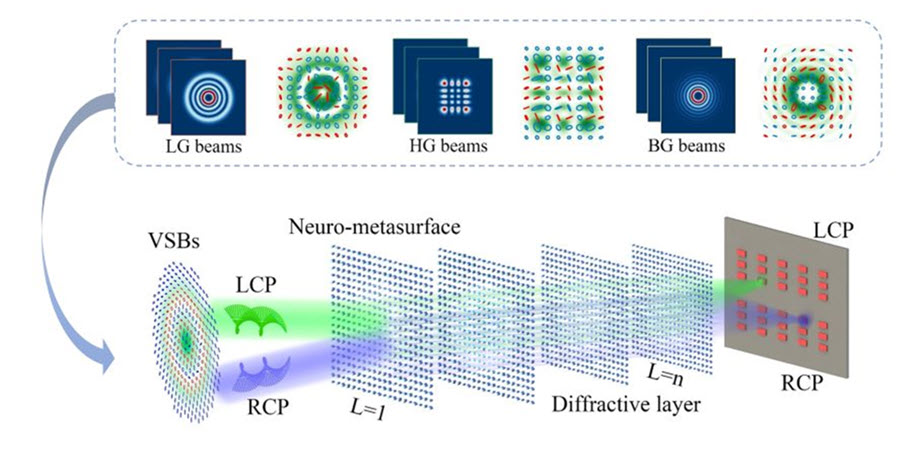From SPIE – The International Society for Optics and Photonics
5.31.24 [Just today from the institution]
New metasurface design enables efficient sorting of vector structured beams, a pivotal step toward the practical application of complex light beams.

Multilayered metasurfaces act as neurons in a multiplexed diffractive neural network (MDNN) for detecting and sorting vector structured beams. Credit: X. Li et al.
In the dynamic realm of optical physics, researchers are continually pushing the boundaries of how light can be manipulated and harnessed for practical applications. As reported in Advanced Photonics Nexus, a groundbreaking study from the Harbin Institute of Technology (HIT) introduces a method for sorting and distinguishing various types of vector structured beams (VSBs), promising significant advancements in optical communication and quantum computing.
Unlike conventional light beams that propagate in simple, straight trajectories, VSBs are engineered to form complex, intricate patterns. These beams transmit information not only through traditional means such as intensity and wavelength but also via sophisticated spatial and polarization configurations. Their versatility makes them ideal for data encoding and communication.
Efficiently managing and utilizing VSBs has historically posed significant challenges. Their inherent complexity demands precise sorting and identification methods for practical applications. Enhancing the efficiency, bandwidth, and security of optical communications and fostering innovations in quantum computing hinge on our ability to handle these intricate beams effectively.
At the heart of the study by the research team at HIT lies a compact, highly efficient device based on a spin-multiplexed diffractive metasurface. This meticulously engineered surface operates at the microscopic level, manipulating light beams with remarkable precision.
The device directs beams of light through a sequence of finely tuned layers of metasurface. Each layer interacts with the light in a precise manner, shaping it incrementally into predetermined patterns. As the light emerges from the device, each VSB type is distinctly separated and identifiable by its unique characteristics. This simultaneous sorting capability opens new possibilities for high-dimensional communication and quantum information processing.
Technological implications include:
Optical communications: Transmitting more data at higher speeds with enhanced security remains a critical goal. The metasurface ability to process complex light beams suggests a potential paradigm shift in data transmission, enabling greater efficiency within existing physical infrastructure.
Quantum computing: Quantum information processing fundamentally diverges from classical computing. Precise control over light beams introduces fresh avenues for speeding up quantum computing systems.
Challenges and outlook
While this research represents a formidable advancement, integrating the device into existing technological frameworks and optimizing it for practical applications remain challenges. Nonetheless, researchers are optimistic about its future impact and actively refining the technology.
Senior corresponding author Professor Weiqiang Ding remarks, “Our breakthrough in light manipulation technology marks a pivotal step toward the practical application of complex light beams. By facilitating precise control over these beams, the technology not only augments existing capabilities but also opens new avenues for scientific exploration.”
The journey from laboratory innovation to widespread practical use is intricate, but with these pioneering advancements, the pathway toward everyday integration becomes increasingly tangible.
See the full article here .
Comments are invited and will be appreciated, especially if the reader finds any errors which I can correct.
five-ways-keep-your-child-safe-school-shootings
Please help promote STEM in your local schools.
SPIE (formerly the Society of Photographic Instrumentation Engineers, later the Society of Photo-Optical Instrumentation Engineers) is an international not-for-profit professional society for optics and photonics technology, founded in 1955. It organizes technical conferences, trade exhibitions, and continuing education programs for researchers and developers in the light-based fields of physics, including: optics, photonics, and imaging engineering. The society publishes peer-reviewed scientific journals, conference proceedings, monographs, tutorial texts, field guides, and reference volumes in print and online. SPIE is especially well-known for Photonics West, one of the laser and photonics industry’s largest combined conferences and tradeshows which is held annually in San Francisco. SPIE also participates as partners in leading educational initiatives, and in 2020, for example, provided more than $5.8 million in support of optics education and outreach programs around the world.
Publications
The society’s first publication, SPIE Newsletter, was launched in 1957. In 1959, the society published its first book, SPIE Photographic Instrumentation Catalog. The newsletter morphed into the society’s first journal, now known as Optical Engineering, SPIE’s flagship monthly journal. Throughout the years, SPIE has created many publications including journals, magazines, newspapers, websites, and books.
Scientific journals
All SPIE journals are peer-reviewed.
Advanced Photonics Co-published by SPIE and Chinese Laser Press, Advanced Photonics is a highly selective, open access, international journal publishing innovative research in all areas of optics and photonics, including fundamental and applied research.
Journal of Applied Remote Sensing (JARS) is an online-only, quarterly published journal on remote sensing.
Journal of Astronomical Telescopes, Instruments, and Systems (JATIS) is published quarterly and covers development, testing, and application of telescopes, instrumentation, techniques, and systems for ground- and space-based astronomy.
Journal of Biomedical Optics (JBO) is published monthly with the latest on optical technology in health care and research.
Journal of Electronic Imaging (JEI), co-published bi-monthly with the Society for Imaging Science and Technology, publishes papers on electronic imaging science and technology.
Journal of Medical Imaging (JMI) is published quarterly and covers fundamental and translational research and applications focused on photonics in medical imaging, which continue to yield physical and biomedical advancements in early detection, diagnostics, and therapy of disease as well as in the understanding of normal.
Journal of Micro/Nanopatterning, Materials, and Metrology Advanced Photonics Co-published by SPIE and Chinese Laser Press, Advanced Photonics is a highly selective, open access, international journal publishing innovative research in all areas of optics and photonics, including fundamental and applied research.
Journal of Nanophotonics (JNP) is an online-only, quarterly published journal on fabrication and application of nanostructures that generate or manipulate light from the infrared to the ultraviolet regimes.
Journal of Optical Microsystems (JOM) is published quarterly and contains papers on cutting-edge research of optical and photonic microsystems, from materials and fabrication of micro-optical and photonic components, through assembly and packaging, to systems and applications.
Journal of Photonics for Energy (JPE) is an e-journal published quarterly that covers fundamental and applied research applications of photonics for renewable energy harvesting, conversion, storage, distribution, monitoring, consumption, and efficient usage.
Neurophotonics, published quarterly, is at the interface of optics and neuroscience covering advances in optical technology applicable to study of the brain and their impact on the basic and clinical neuroscience applications.
Optical Engineering (OE) is the flagship monthly journal of the society, with papers on research and development in all areas of optics, photonics, and imaging science and engineering.

